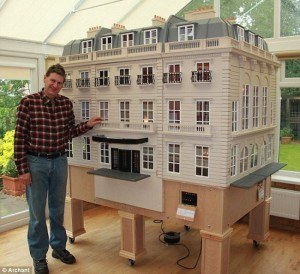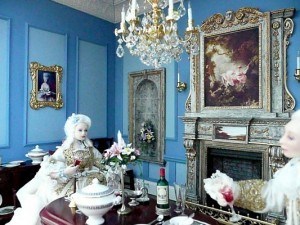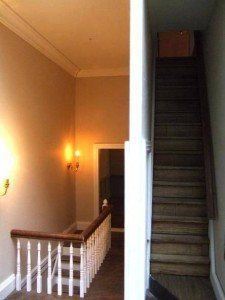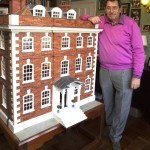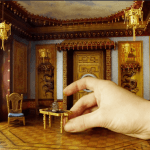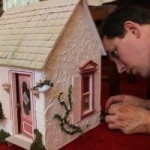Tim Hartnell Miniaturist
Tim and his wife, Angela Hartnell are the owners of Anglia Dolls Houses, which specializes in creating fully decorated, 1/12th scale miniature works. Their standard designs are early Georgian through the Regency period; commissions are from any period.
1920s Luxury Hotel
A recent project is a replica of a 1920s grand hotel, such as The Ritz or The Hotel de Louvre in Paris. It’s huge, weighing 840 pounds and measuring 6′ wide, 4′ deep, 8′ 6” high. It was shipped to its U.S. buyer in 11 separate crates.
Features are a wood-paneled bar, restaurant, ladies powder room, shops, a wine cellar, luggage store, pantry, laundry and a boiler room. The structure is so large, normal dollhouse electrics could not support the massive wattage needed. Off-the-shelf electrical components are used to feed the tiny room circuits. This complex lighting scheme includes 70 electric sockets and over 650 feet of cable. It has 42 switches to control the lights in each of the rooms. The ballroom chandelier has 36 tiny bulbs.
Room Boxes
The Anglia room boxes are built using the same techniques as a room in a complete house. Unless otherwise requested, the room boxes are 18″ wide X 12″ deep and have a height that is relevant to the room type.
A good example of the Hartnell’s work is the room box inspired by the kitchen at Fairfax House in York. This kitchen room box includes a real slate flagstone floor and a large feature arch containing a wide hob grate, chimney crane & cauldron, dummy smoke-jack with spit and drip tray, Hearth & Home closed range and an open bread oven with a glowing firebox beneath. There is a dummy door and a window with plate shelf above. The room box is lit by a kitchen lantern and the coals in the cooking ranges glow.
Kensington Town House
A real Kensington Town House would be desirable for the relatively wealthy. Tim and Angela’s attention to detail captures that appeal in miniature. The grand entrance hall would be used to receive visitors before taking them up the wide staircase with half landing to the reception rooms on the first floor. By the Regency era, townhouse designs accommodated the needs of domestic staffs, with separate staircases for servants and dedicated servants’ working areas.
In the Kensington House dollhouse, the dining room is situated on the ground floor where it can be attended discretely by servants moving from the basement kitchen via a back staircase and jib door. The 1:12 scale family and their visitors need not be exposed to the scurrying and clatter of the staff bringing food to their table.
The Anglia Dolls House Owners
The Hartnells do not have a long history in dollhouses, either in collecting or creating. Tim is a former computer software developer who quit the technology biz to form Anglia Dolls Houses in 2008. He learned about handling wood from his cabinet-maker uncle and in childhood was an avid model-maker. As an adult, he made wooden toys and dolls house for his daughters, later selling such items at regional craft fairs.
Angela Hartnell concentrates on painting, decorating, marbling and general finishing of the projects and takes all the photographs for the website. She owned a dolls house as a child but only really began collecting miniatures when she started helping Tim at craft fairs.
The future looks good for the Hartnells. Their attention to detail is paying off – the waiting list for one of their made-to-order creations is more than a year.
You might be interested in another husband and wife team of miniaturists,
Kevin Mulvany and Susan Rogers.
Susan Downing, with Patrick Owens


